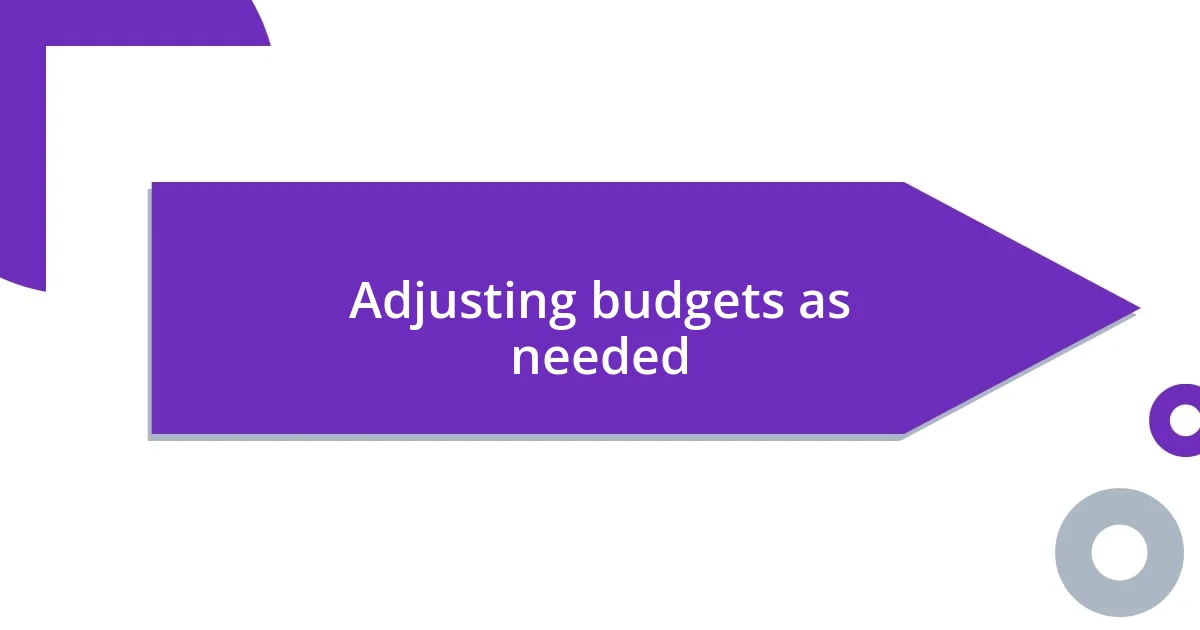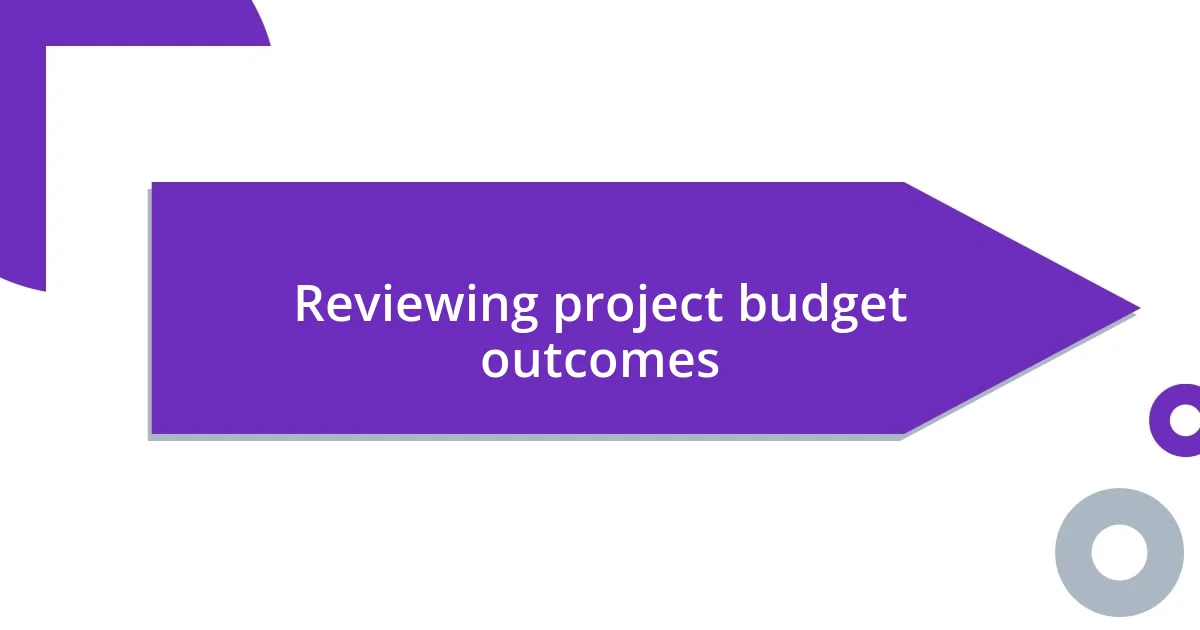Key takeaways:
- Understanding project budgets requires distinguishing between fixed and variable costs, while incorporating contingency planning to handle unexpected expenses.
- Setting clear, specific, and measurable project objectives is critical for aligning teams and streamlining resource allocation.
- Continuous monitoring, open communication, and post-project reviews foster a culture of accountability and improvement in budget management.

Understanding project budget basics
When I first started managing projects, the idea of budgets felt overwhelming. I vividly remember tackling my first significant project, staring blankly at the spreadsheet, unsure where to even begin. Understanding the basics of a project budget is crucial—it’s about knowing your fixed and variable costs, and distinguishing between essential expenditures and nice-to-haves.
One essential aspect I learned is the importance of contingency planning. Have you ever faced unexpected expenses that derailed your timeline? I certainly have! I recall a project where we underestimated the cost of materials, and adding a contingency fund saved us from financial chaos. It’s all about preparing for the unexpected and ensuring you have a buffer to keep your project on track.
Additionally, breaking down the budget into categories can really clarify things. When I started itemizing costs like labor, materials, and overheads, I found it much easier to see where adjustments were needed. Do you find it easier to manage your budget when you categorize your expenses? For me, it was like shining a light on each piece of the project puzzle, allowing me to make informed decisions that ultimately led to success.

Setting clear project objectives
Setting clear project objectives is like laying the foundation of a house; without them, everything can quickly become shaky. Early in my project management journey, I often stumbled here. I remember a project that kicked off without clearly defined goals. As a result, the team was pulling in different directions, and I felt the pressure mounting as deadlines approached. Formulating specific objectives not only aligns the team but also helps streamline budgeting and resource allocation.
To establish effective project objectives, consider these key points:
- Specificity: Clearly outline what you want to achieve. Vague goals lead to confusion—I’ve seen it firsthand when a project lacks clarity.
- Measurable Outcomes: Ensure your objectives can be quantified. This way, you can track progress and gauge success.
- Realistic Goals: Set achievable targets; I’ve had to reign in my ambitions on several occasions to avoid team burnout.
- Time-Bound: Define deadlines for each objective to maintain momentum and accountability. I once missed a critical milestone, and it taught me the importance of keeping timelines in check.
By focusing on these aspects, I’ve seen significant improvements in project cohesiveness and budget management. Remember, it’s about creating a roadmap that everyone can follow, reducing ambiguity and boosting morale along the way.

Estimating costs accurately
Estimating costs accurately is pivotal in project management. Reflecting on my experiences, I’ve often faced the challenge of underestimating costs due to a lack of detail. For instance, during a project aimed at developing a marketing campaign, I barely accounted for creative revisions and had to scramble for funds halfway through. This incident taught me the importance of thoroughly researching all possible expenses, from direct costs to unforeseen expenditures.
I’ve discovered that utilizing historical data can significantly enhance accuracy in estimates. Looking back at previous projects, I often pull expense reports or notes from my team’s discussions around budgeting. It’s intriguing how these insights can highlight patterns, helping to predict future costs more reliably. Have you ever tapped into your past experiences to shape your current budgeting? I certainly find it immensely valuable!
Lastly, involving team members in the estimation process has proven beneficial. There’s wisdom in having diverse perspectives; for example, I once collaborated with a team member who specialized in procurement. Their knowledge uncovered hidden costs I might have overlooked. This collaborative approach not only boosts accuracy but also fosters a sense of ownership among the team—a crucial factor when striving for a successful project outcome.
| Cost Estimation Method | Details |
|---|---|
| Bottom-Up Estimation | Breaks down each component for a detailed view. More accurate but time-consuming. |
| Analogous Estimation | Uses historical data from similar projects. Quick but can be less accurate if comparisons are not close. |
| Expert Judgment | Gathers opinions from experienced team members. Relies on expertise, which might be subjective. |

Allocating resources effectively
When it comes to allocating resources effectively, I’ve found that identifying the right people for the job is crucial. In one project, I remember assigning tasks based on availability rather than skills, which led to frustration and missed deadlines. Have you ever watched a project suffer because the right expertise wasn’t utilized? I have, and it reinforced the idea that a skilled team is the bedrock of resource allocation.
Another strategy I’ve employed is prioritizing tasks based on impact. I recall a project where we had multiple competing tasks, and it felt overwhelming at times. By ranking these tasks according to their potential to drive project success, I was able to focus my team’s efforts on what really mattered. This simple technique not only alleviated stress but also made our resource allocation feel more strategic and purposeful.
Finally, I always emphasize the importance of flexibility in resource allocation. There was a time when an unexpected opportunity arose midway through a project, and I had to quickly pivot our resources. I felt a flutter of anxiety at first, but embracing that change led us to produce an even better outcome. How do you handle unforeseen shifts in resource needs? For me, viewing flexibility as an opportunity rather than a setback has transformed my approach to project management.

Monitoring budget performance
Monitoring budget performance is one of those critical aspects of project management that can make or break an initiative. I know from experience that keeping a close eye on expenditure can feel overwhelming at times. During one project, I implemented weekly budget check-ins with my team, which not only kept everyone accountable but transformed the way we approached our spending. It’s fascinating how regular discussions about our financial health can lead to proactive adjustments before issues balloon into major concerns.
One method I’ve adopted is using visual tools like dashboards to track our budget in real time. Seeing the numbers visually brought clarity and sparked engaging conversations about our financial priorities. I remember a specific project where, as soon as we observed a spending spike, we gathered to discuss ways to recalibrate our strategy. It’s so empowering to involve everyone in these discussions—they bring unique perspectives that can uncover issues I hadn’t considered. Have you tried using visuals in your budget monitoring? If not, I highly recommend it!
Additionally, I find that reflecting on budget performance in relation to project milestones helps in identifying trends early. For example, at the end of a major phase, I conduct a comprehensive review to compare projected costs against actuals. A couple of times, I’ve noticed specific inconsistencies that prompted adjustments for subsequent phases, which not only saved money but also maintained momentum. In your experience, how often do you take a step back to assess your budget’s alignment with project goals? Establishing this practice has been a game-changer for me.

Adjusting budgets as needed
Adjusting budgets as needed is a skill that really matters. I recall a project where our initial budget looked solid, but halfway through, we faced rising material costs. This was a stressful moment for our team, and I knew we had to pivot quickly to avoid derailing the whole project. I gathered everyone for a brainstorming session, inviting each team member to share their thoughts on potential cost-saving measures. The collaborative nature of our discussion not only lightened the mood but resulted in innovative solutions that stabilized our budget.
In my experience, making adjustments also hinges on communication. I remember a time when I noticed our budget slipping, but I hesitated to bring it up, fearing it would upset the team. However, once I opened the floor to discuss budgetary concerns, it became clear we shared the same worries. This transparency not only built trust but empowered us to tackle financial challenges head-on. Have you ever felt that hesitation to address budget issues with your team? I’ve learned that discussing these matters openly ultimately leads to stronger commitment and accountability.
Furthermore, I firmly believe that tracking external factors is crucial for effective budget adjustments. During a project impacted by unexpected regulations, I felt a wave of anxiety wash over me. But instead of panicking, I set up a quick review to assess the implications on our budget. By doing so, we were able to reallocate funds preemptively, avoiding potential cash flow disruptions. It’s intriguing how a proactive approach can change how you view budget adjustments. How do you keep an eye on external factors influencing your projects? I find that being vigilant in this area often leads to smoother transitions when adjustments are necessary.

Reviewing project budget outcomes
Reviewing project budget outcomes is perhaps where the real learning happens. I vividly remember wrapping up a project that had spiraled over budget. As we sat down to dissect our finances, a wave of embarrassment washed over me, but it quickly turned into invaluable insights. The discrepancies raised important questions, like were we miscalculating costs upfront or did unforeseen expenses catch us by surprise? Identifying these pitfalls not only improved my future budgeting but also instilled a culture of financial awareness in my team. Have you ever experienced an eye-opening moment during a budget review? It’s moments like these that create lasting change.
One practice I’ve honed is the post-project budget retrospective. After completing a project, I gather everyone involved and we delve deep into the budget outcomes together. I recall a specific project where this retrospective revealed that our team underestimated resource allocation. Instead of feeling demoralized, we used that information to innovate our budgeting processes moving forward. It’s amazing how sharing those insights can foster a supportive environment where everyone feels invested in continuous improvement. How do you typically analyze your project’s financial performance after completion?
Emotions definitely play a role in these reviews. There’s something cathartic about expressing concerns and celebrating successes collectively. Remember that project where we celebrated coming in under budget? We threw a mini-celebration. Sharing that joy reinforced our team’s cohesion and commitment to financial responsibility. In contrast, during a more challenging review, I learned that acknowledging what went wrong—as uncomfortable as it was—actually paved the way for trust and honesty down the line. Do you find that discussing both wins and losses in budget reviews affects team morale? I’ve found it truly cultivates a genuine sense of ownership and accountability among team members.














